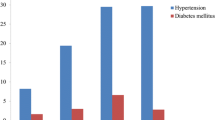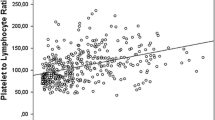Abstract
Purpose
Obstructive sleep apnea (OSA) is independently associated with increased risk for stroke and other cardiovascular diseases. Since activated platelets play an important role in cardiovascular disease, the objective of this study was to determine whether platelet reactivity was altered in OSA subjects with intermittent nocturnal hypoxemia.
Methods
Thirty-one subjects, without hypertension or cardiovascular disease and not taking medication, participated in the study. Subjects were stratified based on OSA-related oxygen desaturation index (ODI) recorded during overnight polysomnography. Platelet reactivity to a broad panel of agonists (collagen, thrombin, protease-activated receptor1 hexapeptide, epinephrine, ADP) was measured by monitoring platelet aggregation and ATP secretion. Expression of platelet activation markers CD154 (CD40L) and CD62P (P-selectin) and platelet-monocyte aggregates (PMA) was quantified by flow cytometry.
Results
Epinephrine-induced platelet aggregation was substantially decreased in OSA subjects with significant intermittent hypoxemia (ODI ≥ 15) compared with subjects with milder hypoxemia levels (ODI < 15) (area under curve, p = 0.01). In addition, OSA subjects with ODI ≥ 15 exhibited decreased thrombin-induced platelet aggregation (p = 0.02) and CD40L platelet surface expression (p = 0.05). Platelet responses to the other agonists, CD62P platelet surface expression, and PMA levels were not significantly different between groups. Reduction in platelet responses to epinephrine and thrombin, and decreased CD40L surface marker expression in significant hypoxemic OSA individuals, is consistent with their platelets being in an activated state.
Conclusions
Increased platelet activation was present in otherwise healthy subjects with intermittent nocturnal hypoxemia due to underlying OSA. This prothrombotic milieu in the vasculature is likely a key contributing factor toward development of thrombosis and cardiovascular disease.
Trial registration
NCT00859950


Similar content being viewed by others
References
Ayas NT, Taylor CM, Laher I (2016) Cardiovascular consequences of obstructive sleep apnea. Curr Opin Cardiol 31:599–605. https://doi.org/10.1097/HCO.0000000000000329
Bauters F, Rietzschel ER, Hertegonne KB, Chirinos JA (2016) The link between obstructive sleep apnea and cardiovascular disease. Curr Atheroscler Rep 18:1–11. https://doi.org/10.1007/s11883-015-0556-z
Barone DA, Krieger AC (2013) Stroke and obstructive sleep apnea: a review. Curr Atheroscler Rep 15:334–340. https://doi.org/10.1007/s11883-013-0334-8
Hoyos CM, Melehan KL, Liu PY, Grunstein RR, Phillips CL (2015) Does obstructive sleep apnea cause endothelial dysfunction? A critical review of the literature. Sleep Med Rev 20:15–26. https://doi.org/10.1016/j.smrv.2014.06.003
Gabryelska A, Lukasik ZM, Makowska JS, Bialasiewicz P (2018) Obstructive sleep apnea: from intermittent hypoxia to cardiovascular complications via blood platelets. Front Neurol 9:635–644. https://doi.org/10.3389/fneur.2018.00635
Dewan NA, Nieto FJ, Somers VK (2015) Intermittent hypoxemia and OSA: implications for comorbidities. Chest 147:266–274. https://doi.org/10.1378/chest.14-0500
Iber C, Ancoli-Israel S, Chesson AL, Quan SF (2007) The AASM manual for the scoring of sleep and associated events: rules, terminology and technical specifications, 1st edn. American Academy of Sleep Medicine, Westchester
Punjabi NM, Newman AB, Young TB, Resnick HE, Sanders MH (2008) Sleep-disordered breathing and cardiovascular disease: an outcome-based definition of hypopneas. Am J Respir Crit Care Med 177:1150–1155. https://doi.org/10.1164/rccm.200712-1884OC
Drosopoulos JHF, Broekman MJ, Islam N, Maliszewski CR, Gayle RB, Marcus AJ (2000) Site-directed mutagenesis of human endothelial cell ecto-ADPase/soluble CD39. Requirement of glutamate174 and serine218 for enzyme activity and inhibition of platelet recruitment. Biochemistry 39:6936–6943. https://doi.org/10.1021/bi992581e
Furman MI, Benoit SE, Barnard MR, Valeri CR, Borbone ML, Becker RC, Hechtman HB, Michelson AD (1998) Increased platelet reactivity and circulating monocyte-platelet aggregates in patients with stable coronary artery disease. J Am Coll Cardiol 31:352–358
Ranucci M, Aloisio T, Di Dedda U et al (2019) Platelet reactivity in overweight and obese patients undergoing cardiac surgery. Platelets 30:608–614. https://doi.org/10.1080/09537104.2018.1492108
El Haouari M, Rosado JA (2009) Platelet function in hypertension. Blood Cells Mol Dis 42:38–43. https://doi.org/10.1016/j.bcmd.2008.07.003
Sudic D, Razmara M, Forslund M, Ji Q, Hjemdahl P, Li N (2006) High glucose levels enhance platelet activation: involvement of multiple mechanisms. Br J Haematol 133:315–322. https://doi.org/10.1111/j.1365-2141.2006.06012.x
Van der Stoep M, Korporaal SJ, Van EM (2014) High-density lipoprotein as a modulator of platelet and coagulation responses. Cardiovasc Res 103:362–371. https://doi.org/10.1093/cvr/cvu137
Alkhiary W, Morsy NE, Yousef AM, El-Saddik AM, Arram EO (2017) Adenosine diphosphate-induced platelets: Aggregability in polysomnographically verified obstructive sleep apnea. Clin Appl Thromb Hemost 23:360–366. https://doi.org/10.1177/1076029615600790
Kondo Y, Kuwahira I, Shimizu M et al (2011) Significant relationship between platelet activation and apnea-hypopnea index in patients with obstructive sleep apnea syndrome. Tokai J Exp Clin Med 36:79–83
Oga T, Chin K, Tabuchi A, Kawato M, Morimoto T, Takahashi K, Handa T, Takahashi K, Taniguchi R, Kondo H, Mishima M, Kita T, Horiuchi H (2009) Effects of obstructive sleep apnea with intermittent hypoxia on platelet aggregability. J Atheroscler Thromb 16:862–869. https://doi.org/10.5551/jat.2188
Akinnusi ME, Paasch LL, Szarpa KR, Wallace PK, El Solh AA (2009) Impact of nasal continuous positive airway pressure therapy on markers of platelet activation in patients with obstructive sleep apnea. Respiration 77:25–31. https://doi.org/10.1159/000158488
Kobayashi K, Nishimura Y, Shimada T et al (2006) Effect of continuous positive airway pressure on soluble CD40 ligand in patients with obstructive sleep apnea syndrome. Chest 129:632–637. https://doi.org/10.1378/chest.129.3.632
Eisensehr I, Ehrenberg BL, Noachtar S, Korbett K, Byrne A, McAuley A, Palabrica T (1998) Platelet activation, epinephrine, and blood pressure in obstructive sleep apnea syndrome. Neurology 51:188–195
Motulsky HJ, Shattil SJ, Ferry N, Rozansky D, Insel PA (1986) Desensitization of epinephrine-initiated platelet aggregation does not alter binding to the alpha 2-adrenergic receptor or receptor coupling to adenylate cyclase. Mol Pharmacol 29:1–6
Kjeldsen SE, Weder AB, Egan B, Neubig R, Zweifler AJ, Julius S (1995) Effect of circulating epinephrine on platelet function and hematocrit. Hypertension 25:1096–1105. https://doi.org/10.1161/01.HYP.25.5.1096
Hakim F, Gozal D, Kheirandish-Gozal L (2012) Sympathetic and catecholaminergic alterations in sleep apnea with particular emphasis on children. Front Neurol 3:1–13. https://doi.org/10.3389/fneur.2012.00007
Jennings LK (2009) Mechanisms of platelet activation: need for new strategies to protect against platelet-mediated atherothrombosis. Thromb Haemost 102:248–257. https://doi.org/10.1160/TH09-03-0192
Jurk K, Jahn UR, Van Aken H et al (2004) Platelets in patients with acute ischemic stroke are exhausted and refractory to thrombin, due to cleavage of the seven-transmembrane thrombin receptor (PAR-1). Thromb Haemost 91:334–344. https://doi.org/10.1160/TH03-01-0044
Henn V, Steinbach S, Büchner K, Presek P, Kroczek RA (2001) The inflammatory action of CD40 ligand (CD154) expressed on activated human platelets is temporally limited by coexpressed CD40. Blood 98:1047–1054. https://doi.org/10.1182/blood.V98.4.1047
Antoniades C, Bakogiannis C, Tousoulis D, Antonopoulos AS, Stefanadis C (2009) The CD40/CD40 ligand system: linking inflammation with atherothrombosis. J Am Coll Cardiol 54:669–677. https://doi.org/10.1016/j.jacc.2009.03.076
Varo N, de Lemos JA, Libby P, Morrow DA, Murphy SA, Nuzzo R, Gibson CM, Cannon CP, Braunwald E, Schönbeck U (2003) Soluble CD40L: risk prediction after acute coronary syndromes. Circulation 108:1049–1052. https://doi.org/10.1161/01.CIR.0000088521.04017.13
Schonbeck U, Varo N, Libby P, Buring J, Ridker PM (2001) Soluble CD40L and cardiovascular risk in women. Circulation 104:2266–2268. https://doi.org/10.1161/hc4401.099447
Berry RB, Budhiraja R, Gottlieb DJ et al (2012) Rules for scoring respiratory events in sleep: update of the 2007 AASM manual for the scoring of sleep and associated events. Deliberations of the sleep apnea definitions task force of the American Academy of Sleep Medicine. J Clin Sleep Med 8:597–619. https://doi.org/10.5664/jcsm.2172
Acknowledgments
This work is dedicated in memory of our colleague and mentor Dr. Aaron J. Marcus, an exceptionally talented scientist and expert in thrombosis and platelet dysfunction, who made enormous contributions to the field of Hematology and was continuously funded by the National Institutes of Health for over 50 years.
Funding
This work was supported by National Institutes of Health grants HL089521 (A.J.M.) and HL047073 (A.J.M., J.H.F.D.), a Merit Review grant I01BX002122 from the United States Department of Veterans Affairs Biomedical Laboratory Research and Development Program (A.J.M., J.H.F.D.), and a National Heart Lung and Blood Institute grant K23 HL094358 (A.C.K.). We also received support from the Clinical Translational Research Center at Rockefeller University Hospital, grant UL1 TR001866 from the National Center for Advancing Translational Sciences, National Institutes of Health and Clinical and Translational Science Award programs, and grant UL1 TR000457-06 from the Clinical and Translational Science Center at Weill Cornell Medicine.
Author information
Authors and Affiliations
Author notes
Aaron J. Marcus is deceased. This paper is dedicated to his memory.
- Aaron J. Marcus
Corresponding author
Ethics declarations
Conflict of interest
The authors declare that they have no conflict of interest.
Ethical approval
All procedures performed in studies involving human participants were in accordance with the ethical standards of the institutional and/or national research committee and with the 1964 Helsinki Declaration and its later amendments or comparable ethical standards.
Informed consent
Informed consent was obtained from all individual participants included in the study.
Additional information
Publisher’s note
Springer Nature remains neutral with regard to jurisdictional claims in published maps and institutional affiliations.
Rights and permissions
About this article
Cite this article
Krieger, A.C., Anand, R., Hernandez-Rosa, E. et al. Increased platelet activation in sleep apnea subjects with intermittent hypoxemia. Sleep Breath 24, 1537–1547 (2020). https://doi.org/10.1007/s11325-020-02021-4
Received:
Revised:
Accepted:
Published:
Issue Date:
DOI: https://doi.org/10.1007/s11325-020-02021-4




